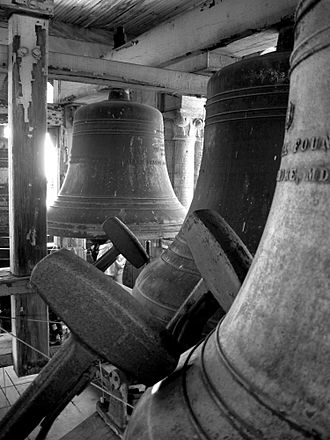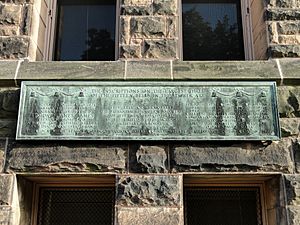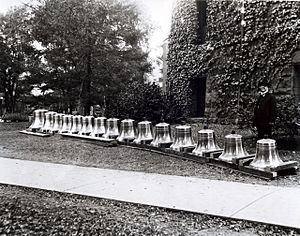Altgeld Chimes facts for kids
Quick facts for kids Senior Memorial Chime |
|
|---|---|

The chime's three largest bells
|
|
| Alternative names | Altgeld Chimes |
| General information | |
| Type | Bell tower housing a chime |
| Address | 323 Altgeld Hall 1409 W. Green St. Urbana, IL 61801 United States |
| Coordinates | 40°06′37″N 88°13′43″W / 40.110370°N 88.228710°W |
| Inaugurated | October 30, 1920 |
| Renovated | 1957, 2017 |
| Cost | $14,000 (equivalent to $204,512 in 2022) |
| Owner | University of Illinois at Urbana-Champaign |
| Height | 132 feet (40 m) |
| Design and construction | |
| Other designers | McShane Bell Foundry (bell casting & installation) |
The Senior Memorial Chime, often called the Altgeld Chimes, is a special musical instrument. It has 15 bells and is located in the Altgeld Hall Tower. This tower is on the main campus of the University of Illinois at Urbana-Champaign in Urbana, Illinois, United States.
Students who graduated from 1914 to 1921 gave this chime as a gift. The United States School of Military Aeronautics also helped. The bells first rang on October 30, 1920. This was during the university's tenth fall homecoming event. Since then, the chime has marked the hours and been used for concerts. The university's School of Music helps manage the chime. Students and local volunteers also help keep it running.
Contents
Discover the Altgeld Chimes
The Altgeld Chimes are more than just bells. They are a beloved part of the University of Illinois campus. Let's explore how they work and their history.
The Bells of Altgeld Hall
The Senior Memorial Chime has fifteen bells. They hang in the top part of Altgeld Hall Tower's belfry. All together, these bells weigh about seven and a half tons. They were made in Baltimore, Maryland by the McShane Bell Foundry. The biggest bell weighs 3,050 pounds and is five feet wide.
A bronze plaque is on the north side of Altgeld Hall. It tells about the bells' dedications. Only the three largest bells have special messages.
- The largest bell honors Edmund J. James. He was the university president from 1904 to 1920.
- The second largest bell remembers the men trained by the United States School of Military Aeronautics.
- The third largest bell has a quote: "Through these chimes the classes of 1914—21 call the multiplying and majestic company of students and graduates to join them in gratitude, loyalty, and devotion to their alma mater."
The Chime's Clock System
The graduating class of 1922 gave a Seth Thomas clock to the university. This clock allows the chime to ring automatically. It rings the full and quarter hours of the day. The bronze plaque on the tower also mentions this clock.
The clock uses a system of wires to ring the four lowest bells. It has hammers that hit the outside of each bell. This system plays the famous Westminster Quarters tune. Sadly, the Seth Thomas clock does not work anymore.
How the Chime is Played
The playing chamber for the chime is seven stories high. Inside, there is a special keyboard called a chimestand. The McShane Bell Foundry made this keyboard just for these bells. Each bell has its own lever on the keyboard.
When a player pushes a lever, it pulls a steel cable. This cable makes a clapper hit the bell. The chime's notes range from a low D to a high G. However, it is missing a low D sharp and both F natural notes.
The notes were chosen carefully. This setup allows the chime to play the university's school song, "Illinois Loyalty." Because some notes are missing, music often needs to be changed. Players usually choose songs in keys like G major, D major, or A major. These keys do not use the F natural note.
Meet the Chimesplayers
The students who play the chime are called chimesplayers. They are part of a student group called the Altgeld Ringers. They hold concerts every weekday when classes are in session. These concerts are from 12:50 PM to 1:00 PM.
Special concerts also happen on important days. These include Homecoming Weekend, Founders Day, and graduation evening. Sometimes, informal concerts are played randomly. These happen during the last ten minutes of an hour. It is a tradition to play the university's alma mater, "Hail to the Orange," at every concert.
The leader of the chimesplayers is called the chimesmaster. The chime has almost always had a chimesmaster. However, the university officially recognized this role in September 2017. The chimesmaster supervises the players. They also do routine maintenance and represent the instrument. Since 1958, there have been four university chimesmasters.
| Chimesmaster | Tenure |
|---|---|
| Albert Emmett Marien | 1958 — 1994 |
| Susanne Kathryn Wood | 1994 — 2017 |
| Jonathon Murray Smith | 2018 — 2019 |
| Christina Marie Horton | 2019 — Present |
History of the Altgeld Chimes
The Altgeld Chimes have a rich history, starting with a student's big idea.
The Idea to Build the Chime
The University of Illinois class of 1914 wanted to buy a chime for the university. They planned to do this with the next seven graduating classes. Hale P. "Pete" Daugherty was a student leader. He was known as the "Father of the Chimes." As editor of the Daily Illini newspaper, he campaigned for the idea.
Hazen S. Capron, a bank chairman, suggested a plan. Each senior class would give $1,000 to a special fund. This money would be invested. Once the fund reached $10,000 or more, a chime could be bought. The class of 1914 quickly adopted this plan. They successfully raised the first $1,000.
The fund grew slowly for the next five years. The classes from 1915 to 1919 struggled to raise their $1,000. Also, the money earned little interest because of World War I. By early 1920, Victor Cullin, a student from the class of 1920, led a new effort. He aimed to raise $4,000 from the classes of 1920 and 1921. This would bring the total to $10,000.
His campaign was very successful. They raised $5,000, enough for a thirteen-bell chime. But before the contract was signed, Dean Thomas Arkle Clark had a question. Could the thirteen-bell chime play the song "Illinois Loyalty"? It turned out two more bells were needed. So, he stopped the purchase. He then found a memorial fund of about $2,500. This fund was raised by the United States School of Military Aeronautics. It could be used if one bell honored them.
The bells were bought for about $14,000. They came from the McShane Bell Foundry in Baltimore. Professor James McLaren White handled all the contracts. He was the university's supervising architect. After the bells were made, Albert Austin Harding and Lloyd Morey inspected them. Harding was the Director of Bands. McShane delivered and installed the chime in time for homecoming.
On October 30, 1920, the dedication ceremony took place. Hundreds of people gathered at Altgeld Hall Tower. Victor Cullin formally presented the chime. Trustee Robert Ward accepted it for the university. President Kinley spoke and officially dedicated the instrument. A McShane employee then rang the chime for the first time. They played several songs, ending with "Illinois Loyalty."
Early Years and Renovations
Not much is known about the chime's history right after its first day. However, it was played regularly until 1941. By then, the chime needed major repairs. These repairs would cost about $10,000. The university, with help from the University of Illinois Foundation, renovated the chime. This happened during the building's renovation in 1956-1957.
Chimesmasters Albert Marien and Sue Wood
In 1958, Albert Marien became the new chimesmaster. He was a university auditor. He started by himself but soon created a team of student chimesplayers. Marien developed a formal teaching program. The Senior Memorial Chime then began hosting daily concerts and public tours. This continued for 60 years.
Sue Wood, a plant pathologist, discovered the chime in 1971. She joined Marien's program. In 1994, she took over as chimesmaster when Marien retired. She served until her retirement in 2017.
The Idea of a Carillon Upgrade
During his time as chimesmaster, Albert Marien had a big dream. He wanted to upgrade the Senior Memorial Chime to a four-octave carillon. A carillon is a much larger bell instrument. Another idea was to build a separate carillon in a new campanile. This idea had been suggested many times since 1913. Upgrading to a carillon would allow players to play many more songs.
When Marien retired in 1994, enough money was raised to buy a new bell. This 347-pound F natural bell was dedicated to Marien. It recognized his efforts for the chime and the upgrade project. This bell is now in a display case at the University of Illinois Willard Airport.
In 1998, a fund was set up for donations. Donations over $1,000 would be recognized with a bronze plaque. About $500,000 was eventually raised for the bells. However, it was found that Altgeld Hall Tower could not hold the extra weight. The new carillon would weigh nearly eight tons of bronze, plus steel structures.
Because of this, the university decided to build a new campanile. This new tower would house the carillon. This led to the construction of the McFarland Carillon on the South Quad.
|




